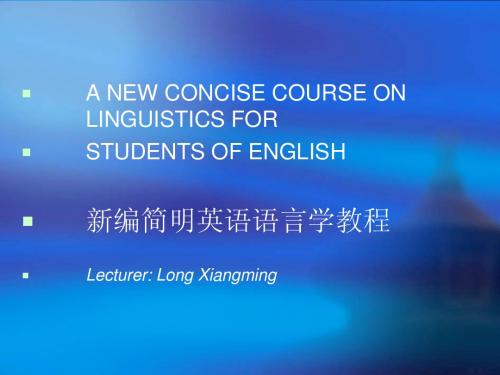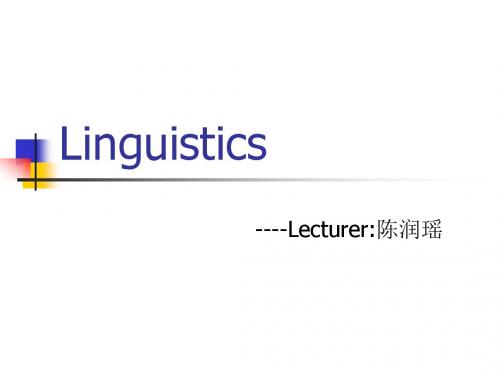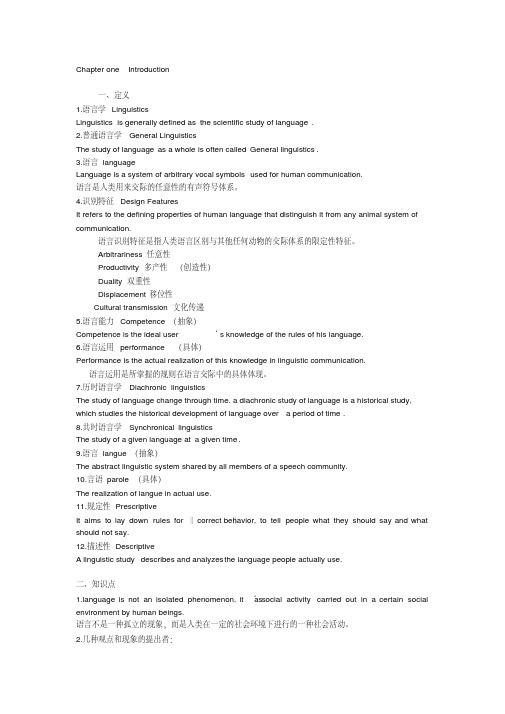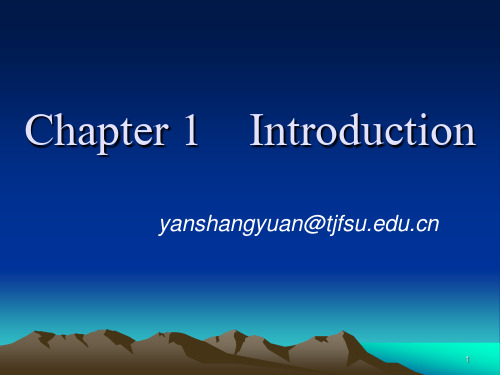Chapter 1 语言学-Introduction
Chapter 1 Introduction

Anthropological linguistics(人文语言学) uses the theories and methods of anthropology to study language variation and language use in relation to the cultural patterns and beliefs of man.
to be and describing how things are
Prescriptive: the early study of language aims to lay down
rules for correct and standard behavior in using languages, such as grammars, to set models for language users to follow. Descriptive: the study of language aims to describe and analyze the language people actually use, be it correct or not; modern linguistic study is supposed to be scientific and objective, they believe that whatever occurs in language people use should be described and analyzed in their investigation.
Phonetics(语音学) is the branch of linguistics which studies the characteristics of speech sounds and provides methods for their description, classification and transcription. Phonology(音韵学) is the branch of linguistics which studies the sound patterns of languages. Morphology(词法) is the branch of linguistics which studies the formation of words. Syntax(句法) is the branch of linguistics which studies the rules governing the combination of words into sentences. Semantics(语义学) is the branch of linguistics which studies the meaning of language.
新编简明英语语言学教程chapter1Introduction剖析

Descriptive vs. prescriptive
Synchronic vs. diachronic Langue vs. parole Competence vs. performance
Prescriptive vs. Descriptive
Don't say X. People don't say X. The first is a prescriptive command, while the second is a descriptive statement. The distinction lies in prescribing how things ought to be and describing how things are.
Prescriptive vs. Descriptive
Prescriptive: to lay down rules for “correct and standard” behavior in using language. (modern linguistics) Descriptive: to describe and analyze the language people actually use. (traditional grammar)
Prescriptive vs. Descriptive
The nature of linguistics as a science determines its preoccupation with description instead of prescription.
Synchronic vs. Diachronic
新编简明英语语言学 第一章

What is linguistics?
---It is a scientific study because it is based on the systemetic investigation of linguistic data, conducted with reference to some general theory of language structure.
> Modern linguistics regards the spoken language as primary, not the written. Traditional grammarians tended to emphasize the importance of the written word.
---Hall, 1968
语言是“人类利用约定俗成的任意性视听符号借以相互交流和影响的习惯体 系”。
---霍尔 , 1968
What is language?
From now on I will consider language to be a set (finite or infinite) of sentences, each finite in length and constructed out of a finite set of elements.
synchronic and diachronic
>The description of a language at some point of time in history is a synchronic study.
对历史上某一时间点的语言状况 所作的研究是共时研究
>The description of a language as it changes through time is a diachronic study.
Chapter 1 Introduction 绪论(现代语言学).

Chapter 1 Introduction 绪论1. What is linguistics? 什么是语言学?1.1 definition 定义Linguistics is generally defined as the scientific study of language.语言学是对语言进行科学研究的学科。
Languages in general 针对所有语言而言A scientific study of language is based on the systematic investigation of data, conducted with reference to some general theory of language structure.语言进行科学地研究最根本的是要对语言材料进行系统的调查研究,并在语言结构的一般理论指导下进行。
The linguist has to do first is to study language facts, i.e. to see how language is actually used; then he formulates some hypotheses about the language structure.语言学家首先必须研究语言材料,即要观察一般情况下语言的使用方法,继而对语言的结构具体地提出一些假设。
A linguistic theory is constructed about what language is and how it works.一套语言学理论是说明语言的本质内容以及这些语言是如何发挥作用的。
1.2 The scope of linguistics 语言学的研究范畴The study of language as a whole is often called general linguistics. This deals with the basic concepts, theories, descriptions, models and methods applicable in any linguistic study.把语言学作为一个整体而进行的全面的语言学研究一般称为普通语言学。
chapter_1_introduction

第二语言习得Second Language Acquisition: getting the whole picture第二语言习得研究的主要问题L2学习者在习得第二语言时究竟获得了什么L2学习者是怎样习得第二语言的L2语言习得有哪些个体差异语言教学对第二语言习得有何影响1. 学习者在L2习得过程中获得了什么为了弄清楚这个问题,学者们收集了大量的学习者的语言材料,并对这些材料进行系统的描写,试图发现学习者习得第二语言的规律。
早期的第二语言习得研究主要集中在学习者的语言系统的描写上。
2. 学习者是怎样获得第二语言的第二语言习得研究的目的是要对学习者的习得过程做出解释。
Ellis认为,可以从两个方面对学习者的习得过程做出解释:一是从社会语言学的角度,即从语言习得的社会环境这些外部因素的影响来阐释学习者的习得过程;二是从认知心理学的角度,即从语言习得内在的心理因素来阐述第二语言的习得过程。
3. 学习者的个体差异问题这方面的研究主要集中在学习者第二语言习得的个体差异问题上。
比如学习者在语言习得过程中表现出的学习速率的差异、学习方式的差异、学习风格的差异以及学习成果的差异等。
这方面研究是关于第二语言学习者自身的研究。
4. 语言教学对第二语言习得的影响•大多数早期的第二语言习得研究主要是考察学习者的自然习得。
这个时期的研究强调自然习得,忽视了语言教学的作用。
•现在人们开始转向课堂教学环境的第二语言习得,并试图说明教学对第二语言习得的影响。
目的是为了提高语言教学的效率。
1. 语法-翻译法Grammar-Translantion Method 2.听说法Audio-lingual Method3. 视听法Audio-Visual Method4. 全身反应法Total Physical Response5. 直接法Direct Method6. 交际法(交际语言教学法)Communicative Approach7. 认知法Cognitive Approach8. 阅读法Reading Method9. 自然法The Natural Approach10. 自觉实践法Self-motive MethodMethod11. 社团语言学习法Community Language Learning 12. 暗示法Suggestopedia第二语教学法流派Grammar Translation(语法翻译法)语言学基础:历史比较语言学认为一切语言起源于同一种语言,语言与思维统一,因而各语言间规则相同,词汇表达意义相同,只是发音、拼写不同,因而强调翻译,早期认为语法最重要,重视语言规范,因而强调语法。
语言学基础introduction

Chapter 1 Introduction1.1 What is linguistics?1.1.1 Definition: Linguistics is the scientific study of language.language: language in general, not any particular language, e.g. English,Chinese, Arabic, and Latin.1.1.2The Scope of linguisticsA)general linguisticsThe study of language as a whole is often called general linguistics.basic concepts: language; sentence; wordstheories:descriptions:models:methods applicable in any linguistic study:B) main branches of linguisticsLanguage study focuses on Meaning and Form.i) Form:soundwritten1) PhoneticsThe study of sounds used in linguistic communication.2) PhonologyThe study of the way in which the sounds are put together and used to convey meaning in communication.3) MorphologyThe study of the way in which the symbols are arranged and combined to form words .4) SyntaxThe study of rules which govern the combination of words to form grammatically permissible sentences in languages.5) Semantics: meaning in languageThe study of meaning is known as semantics.6) Pragmatics: meaning in contextWhen the study of meaning is conducted, not in isolation, but in the context of language use, it becomes another branch of linguistic study called pragmatics.C) MacrolinguisticsLinguistics is not the only field concerned with language. Other disciplines such as psychology, sociology, anthropology, artificial intelligence, medicine and education etc. are also preoccupied with language.1) SociolinguisticsThe study of the social aspects of language and its relation with society forms the core of the branch called sociolinguistics.2) PsycholinguisticsIt relates the study of language to psychology.e.g. to study language development in children, such as the theories of languageacquisition;3) Applied linguisticsa) the study of second and foreign language learning and teaching.b) the study of language and linguistics in relation to practical problems. It usesinformation from sociology, psychology, anthropology and information theory as well as linguistics in order to develop its own theoretical models of language and language use, and then uses this information and theory in practical areas.1.1.3 Linguistics as a ScienceThree adequaciesHow can we appraise the extent of success in scientific study? There are three levels to consider, namely observation, description, and explanation. What a linguist seeks for can be summarized as three adequacies correspondingly.a) observational adequacyA successful research is expected to be adequate in observation at first.It is characterized by correctly specifying what is observed to be phonologically, morphologically, syntactically, semantically, or pragmatically well-formed or ill-formed.b) descriptive adequacyProper description is based on adequate observation, and a piece of scientific work is descriptively adequate if it provides a principled account of the native speaker‟s intuiti ons about the structure of the linguistic phenomenon observed.c) explanatory adequacyExplanatory adequacy is the ultimate goal of any scientific exploration.In linguistics, a theory attains explanatory adequacy just in case it provides a descriptively adequate grammar for every natural language, and does so in terms of a maximally constrained set of universal principles which represent psychologically plausible natural principles of mental computation.1.2 What is language?1.2.1 Design featuresDesign features refer to the defining properties of human language that distinguish it from any animal system of communication.The framework of the design features was proposed by the American linguist Charles Hockett.1) ArbitrarinessArbitrariness means that there is no logical connection between meanings and sounds.Why?a) different languages may have different sounds to represent the same object thatexists in society.b) the same sound may express different meaningsexception: onomatopoeia: based on the natural voices.2)DualityDEFINITION: Language is a system, which consists of two sets of structures, or two levels. At the lower or the basic level there is a structure of sounds, which are meaningless by themselves. But the sounds of language can be grouped and regrouped into a large number of units of meaning, which are found at the higher level of the system.3) ProductivityDEFINITION: Language is productive or creative in that it makes possible the construction and interpretation of new signals by its users.comparing with animal communication systemse.g. an experiment on bee dance:Bee communication regarding location has a fixed set signals, all of which relate to horizontal distance. The bee cannot manipulate its communicating system to create a “new” message indicating vertical distance.4) DisplacementDEFINITION:Language can be used to refer to things which are present or not present, real or imagined matters in the past, present, or future, or in far-away places.Animals are under “immediate stimulus control”.Human language is, unlike animal communication systems, stimulus free.5) Cultural transmissionLanguage cultural transmission means that language is culturally transmitted. It is passed on from one generation to the next through teaching and learning, rather than by instinct.1.2.2 Definitions of languageLanguage is a system of arbitrary vocal symbols used for human communication.1.2.2.1Language is a systemelements of language are combined according to rules.a) rules of sound systemb) rules of written system1.2.2.2 Language is arbitrary and symbolic1.2.2.3 Language is vocala) the primary medium for all languages is sound.b) writing systems came into being much later than the spoken forms.c) some language only have sound systems and no writing systems1.2.2.4 Language is human-specific1.2.2.5 communication vs information1.2.3 Knowledge of language: endowed or conventional?TIME-HONORED PROBLEMS•WHAT IS KNOWLEDGE OF LANGUAGE?•WHERE DOES IT COME FROM?Aristotle (384-322 B.C.):Language is arrived at by convention and agreement of the speakers of a given language.BEHA VIORISMEMPIRICISMOur brain was blank when we were born. Language is a social, empirical entity.B.F. Skinner: the American psychologist and a famous Harvard behaviouristThe famous quotation “language is behaviour ”Verbal behaviour is the same as any other fundamental respect of non-verbal behaviour.The occurrence of behaviours is dependent upon three crucial elements:a stimulus, which serves to elicit behaviour;a response triggered by a stimulus;reinforcement, which serves to mark the response as being appropriate (or inappropriate) and encourages the repetition (or suppression) of the response in the future.Verbal behaviour:the stimulus as what is taught (language input),the response as the learner‟s reaction to the stimulus,the reinforcement as the approval or praise (or discouragement) of the teacher or fellow students.Argument for“poverty of the stimulus”●a) The child‟s linguistic experience (stimulus) is not sufficient to justify theadult grammar.●b) As far as a child is concerned, an utterance containing a mistake is justanother piece of linguistic experience to be treated on a par with error-free utterance. But they still know the correct grammar.●c) A child and a chimpanzee both live in the same language environment, onlythe child can learn the language.Plato (427?-347 B.C.)There is a universally correct and acceptable logic of language for man to follow in expressing his ideas.NATIVISMMENTALISMThere is a biological, physiological entity inside our brain which decides that we speak.Language faculty/(LAD=Language Acquisition Device): Human beings do have an inborn knowledge of language which must be universally correct and acceptable, the location of such innate knowledge just in our genes.Experience of L—LF—Grammar of LChomsky’s epistemology of the knowledge of language●The initial state of human language faculty is called UG(Universal Grammar).●UG(universal grammar): Every speaker knows a set of principles which applyto all languages and also a set of (binary) parameters that can vary from one language to another.principles:all human languages have the subject, verb, and object.reflexible pronoun principle: the reflexible pronoun should take the noun in the same clause as antecedent.parameters:binary parameter:the position of the wh-element in the sentence●Due to the effect of later experience, our brain/mind develops from the initialstate into the steady state, which corresponds to the competence of speaking a human language.experienceUG----------------PG (Particular Grammar)PG=a.UG1.3 Some important distinctions in linguistics1.3.1Prescriptive vs. descriptivePrescriptive and descriptive represent two different types of linguistic study. Descriptive study:If a linguistic study aims to describes and analyze the language people actually use, it is said to be descriptive.Prescriptive study:If a linguistic study aims to lay down rules for “co rrect and standard” behavior in using language, it is said to be prescriptive.1.3.2 Synchronic vs. diachronic--by Ferdinand de Saussure.synchronic study: the description of a language at some point of time in history. diachronic study: the description of a language as it changes through time. A diachronic study of language is a historical study; it studies the historical development of language over a period of time.1.3.3 Speech and writingSpeech and writing are the two major media of linguistic communication.The spoken language as the natural or the primary medium of human language.1) speech is prior to writing: (from the point of view of linguistic evolution)2)Speech is always the way in which every native speaker acquires his mothertongue, and writing is learned and taught later when he goes to school.3) Spoken language reveals many true features of human speech while writtenlanguage is only the “revised” record of speech.4) In everyday communication, speech plays a greater role than writing in termsof the amount of information conveyed.1.3.4 Langue and paroleThe distinction between langue and parole was made by the Swiss linguist Ferdinand de Saussure.1) definitionA) langue:a) the abstract linguistic system shared by all the members of a speech community(a social code);b) the set of conventions and rules which language users all have to abide by;c) abstract, it is not the language people actually use.d) relatively stable, it does not change frequently.B) parole:a) the realization of langue in actual use.b) the concrete use of the conventions and the application of the rules.c) concrete, it refers to the naturally occurring language events.d) varies from person to person, and from situation to situation.2) The significances of the distinction:a) it is convenient in that it delimits an area of enquiry which is manageable: thatarea is langueb) the concept of langue can be said to capture the central and determining aspectof language itself.3) The relation between the langue and parolea) Langue comes from parole.b) Parole is guided by langue.1.3.5 competence and performanceProposed by the American linguist Noam Chomsky.1) definitionCompetence: the ideal user‟s knowledge of the rules of his language. Performance: the actual realization of this knowledge in linguistic communication.2) The relation between the competence and performancea) competence is essential and primary; performance is the residual category of secondary phenomena, incidental, and peripheral.b) competence and performance are quite different phenomena and you cannotdirectly infer one from the other.3) The difference between the two pairs of concepts: langue vs parole and competence vs performancei)similarities:a) It represents a similar dichotomy of knowledge and behaviour.b) It represents a similar demarcation of the scope of linguistic enquiry.c) They are both be glossed in terms of abstract knowledgeii) differences:a) the nature of knowledge is conceived of in very different ways.--Saussure took a sociological view of language and his notion of langue is a matter of social conventions.--Chomsky looks at language from a psychological point of view and to him competence is a property of the mind of each individual.b) the different study interest--Langue, the focus of attention will be in what makes each language different.--Competence, the focus of attention will be in what makes languages alike.1.3.6 Traditional grammar and modern linguistics1) definition:Modern linguistics: The beginning of modern linguistics was marked by the publication of F. de Saussure‟s book Course in General Linguistics in the early 20th century.Traditional grammar: The general approach traditionally formed to the study of language over the ye ars, before the book “Course in General Linguistics” was published.2) differences between traditional grammar and modern linguistics:a) modern linguistics is descriptive while traditional grammar is prescriptive.b)modern linguistics regards the spoken language as primary, not the writing.Traditional grammarians, on the other hand, tended to emphasize, the importance of the written word.c) traditional grammar forces languages into a Latin-based framework, but modernlinguistics does notReading recommendationBeginner-friendly:S. C. Poole: An Introduction to Linguistics. Macmillan Publishers Ltd, 1999; 外语教学与研究出版社2000 (刘润清导读)。
笔记_新编简明英语语言学教程_复习资料讲解

Chapter one Introduction一、定义1.语言学LinguisticsLinguistics is generally defined as the scientific study of language.2.普通语言学General LinguisticsThe study of language as a whole is often called General linguistics.3.语言languageLanguage is a system of arbitrary vocal symbols used for human communication.语言是人类用来交际的任意性的有声符号体系。
4.识别特征Design FeaturesIt refers to the defining properties of human language that distinguish it from any animal system of communication.语言识别特征是指人类语言区别与其他任何动物的交际体系的限定性特征。
Arbitrariness任意性Productivity多产性(创造性)Duality双重性Displacement移位性Cultural transmission文化传递5.语言能力Competence(抽象)Competence is the ideal user‘s knowledge of the rules of his language.6.语言运用performance(具体)Performance is the actual realization of this knowledge in linguistic communication.语言运用是所掌握的规则在语言交际中的具体体现。
7.历时语言学Diachronic linguisticsThe study of language change through time. a diachronic study of language is a historical study, which studies the historical development of language over a period of time.8.共时语言学Synchronical linguisticsThe study of a given language at a given time.9.语言langue(抽象)The abstract linguistic system shared by all members of a speech community.10.言语parole(具体)The realization of langue in actual use.11.规定性Prescriptivebehavior, to tell people what they should say and what It aims to lay down rules for ‖correct‖ should not say.12.描述性DescriptiveA linguistic study describes and analyzes the language people actually use.二、知识点a social activity carried out in a certain socialnguage is not an isolated phenomenon, it‘senvironment by human beings.语言不是一种孤立的现象,而是人类在一定的社会环境下进行的一种社会活动。
新编语言学教程 Chapter 1 Introduction(课堂PPT)

1.2 Linguistics vs. Traditional grammar 1.3 The differences between linguistics and
• The course is intended to introduce undergraduates the major components of modern linguistics, the main concerns, explorations, and discoveries of this subject, the principles and methods of its different branches, the views and contributions of influential researchers, and important models and disputes between traditions and schools.
18
The scope or major branches of linguistics
• Theoretical linguistics 1. Phonetics 2. Phonology 3. Morphology 4. Syntax 5. Semantics • Use of linguistics 1. Applied linguistics 2. Sociolinguistics 3. Psycholinguistics
6
1.1.2 Linguistics as a science
- 1、下载文档前请自行甄别文档内容的完整性,平台不提供额外的编辑、内容补充、找答案等附加服务。
- 2、"仅部分预览"的文档,不可在线预览部分如存在完整性等问题,可反馈申请退款(可完整预览的文档不适用该条件!)。
- 3、如文档侵犯您的权益,请联系客服反馈,我们会尽快为您处理(人工客服工作时间:9:00-18:30)。
“From now on I will consider language to be a set (finite or infinite) of sentences, each finite in length and constructed out of a finite set of elements.” --Noam Chomsky (1928- ): Syntactic Structures (1957)
5
2. What is Language?
Language “is not to be confused with human speech, of which it is only a definite part, though certainly an essential one. It is both a social product of the faculty of speech and a collection of necessary conventions that have been adopted by a social body to permit individuals to exercise that faculty”. --Ferdinand de Saussure (1857-1913): Course in General Linguistics (1916)
The dog barks wow wow in English but “汪汪 汪” in Chinese.
17
Language is not so arbitrary at the syntactic level.
He came in and sat down. He sat down and came in. He sat down after he came in.
The link between a linguistic sign and its meaning is a matter of convention.
2
1. Why Study Language?
Language is such an integral part of our life and humanity that too much about it has been taken for granted. The following list of myths and fundamental views about language will tell us how much we know about language.
Chapter One
Invitations to Linguistics
Teaching Focus
1. Why Study Language? 2. What is Language? 3. Design Features of Language 4. Origin of language 5. Functions of language 6. What is Linguistics? 7. Main branches of linguistics 8. Macrolinguistics 9. Important distinctions in linguistics
15
Human language is „unique‟
Arbitrariness
Duality
Creativity
Displacement
Cultural Transmission
16
3.1 Arbitrariness
Saussure: the forms of linguistic signs bear no natural relationship to their meaning Language is arbitrary. There is no logical connection between meanings and sounds, even with onomatopoeic words:
4
1.2 Some fundamental views about L
Children learn their native language swiftly, efficiently and without instruction. Language operates by rules. Everyone speaks a dialect. Language slowly changes. Languages are intimately related to the societies and individuals who use them. Writing is derivative of speech.
9
Language is “the institution whereby humans communicate and interact with each other by means of habitually used oral-auditory arbitrary symbols.” --Robert A. Hall (1911-1997): Introductory Linguistics (1964)
-- Our textbook (2006)
14
3. Design Features of Language
Language distinguishes human beings from animals in that it is far more sophisticated than any animal communication system. The features that define our human languages is called design features.
(1999)
13
“Language is a means of verbal communication.”
It is instrumental in that communicating by speaking or writing is a purposeful act. It is social and conventional in that language is a social semiotic and communication can only take place effectively if all the users share a broad understanding of human interaction including such associated factors as nonverbal cues, motivation, and sociocultural roles.
Language: An Introduction to the Study of Speech (1921)
7
“A language is a system of arbitrary vocal symbols by means of which a social group cooperates.” --Bernard Bloch (1907-1965) & George Trager (1906-1992): Outline of Linguistic Analysis (1942)
11
“... in a sense all definitions [of language] are, by themselves, inadequate, since, if they are to be more than trivial and uninformative, they must presuppose ... some general theory of language and of linguistic analysis.” --R. H. Robins (1921-2000): General Linguistics (1989)
10
“The question „What is language?‟ is comparable with -- and, some would say, hardly less profound than -- „What is life?‟, the presuppositions of which circumscribe and unify the biological sciences... it is not so much the question itself as the particular interpretation that the biologist puts upon it and the unravelling of its more detailed implications within some currently accepted theoretical framework that nourish the biologist's day-today speculations and research. So it is for the linguist in relation to the question „What is language?‟” --John Lyons (1932- ): Language and Linguistics (1981)
“Language is a system of arbitrary vocal symbols used for human communication.” (recommend to remember) --Ronald Wardhaugh: Introduction to Linguistics (1977)
